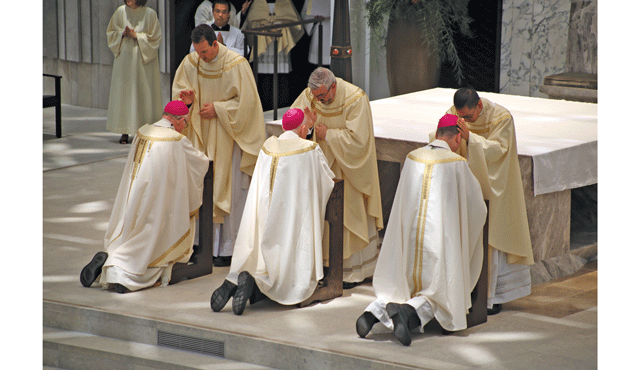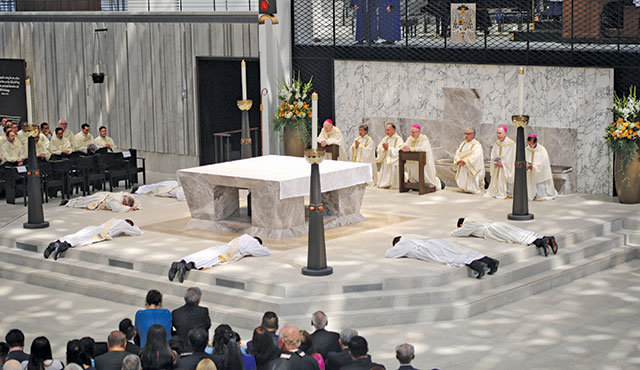The priest shortage in the Catholic Church has been an ongoing concern – some would call it a crisis – for decades. The numbers are sobering: Between 1980 and 2012, the ratio of Catholics per priest worldwide rose from 1,895 to 2,965. Last October, the Vatican reported that this ratio is now 3,210 Catholics per priest.
The good news on the home front is that the Diocese of Orange won’t be in panic mode any time soon. While more clergy are always welcome to any diocese, the number of priests and deacons, as well as those in training, remains at a healthy level.
“If you compare [the numbers] now to 50 years ago, there is a discrepancy in the number of priests,” says Fr. Brandon Dang, the Diocese’s director of vocations. “And while overall we can always use more good men to answer the call to the priesthood, at the local level we’re blessed to have a good number of priests, relative to other dioceses.”
Fr. Brandon notes that an estimated 150 to 200 priests serve in the Diocese, and that 23 men are currently in formation to serve after they’re ordained. In addition, 148 active deacons call the Diocese of Orange home, says Deacon Frank Chavez, director of the Office of the Diaconate.
“There’s no lack of interest in the diaconate,” Deacon Frank says. “We’re growing like crazy, and we don’t recruit.” Nevertheless, he adds, “It’s always good to have more deacons. We age and retire, so we need to get younger men in there to take care of that attrition.”
Thirteen men will be ordained as deacons this fall, and Deacon Frank notes that there are currently 20 men in the diaconate class of 2023. “I put out a notice to the priests to nominate men for diaconate formation, and [getting interested men] is usually not much of an effort,” he says. “We don’t pick all of them for formation, since the discernment process during the first six months is so demanding. Usually the guys who make it through that period end up finishing. We may lose two or three per class.”
“Every parish in the Diocese – except for two – has at least one deacon,” Deacon Frank says, adding that the need for Spanish-speaking deacons in Hispanic neighborhoods is greater. “They can be bilingual or even monolingual.”
Bishop Kevin Vann has encouraged Fr. Brandon, vocations director since July 2019, to apply his youth and enthusiasm in appealing to men interested in looking at the priesthood as a lifelong calling. “Being a witness and using all the tools in our arsenal – including social media, work in the parishes and outreach – informs us as we determine how to best create missionary disciples who will become the leaders in evangelization work,” Fr. Brandon says.
He sees two elements as essential to keeping his work in line with Bishop Vann’s Strategic Plan: “We must develop a priestly identity as spiritual fathers to the parishioners. And we must help with the preaching aspect of the priesthood. Many people obviously put a lot of importance to what their priest says.”
Shepherding good men through clergy formation is not without its challenges. “The [diaconate] class being ordained started out with about 80 men,” Deacon Frank says. “During the discernment process, they drop out or they don’t get selected. There were 16 who were still there after six months.” While some quickly learn that they don’t qualify, others find the dedication and commitment too demanding. “But you don’t have to be a deacon to serve in the Church,” Deacon Frank says. “Look at what our lay people do. There are so many opportunities to help.”
And what Fr. Brandon notes about the number of priests in the Diocese certainly applies to deacons: “We prefer quality over quantity.”
The COVID pandemic has had a significant impact on the work and formation of the Diocese’s priests and deacons. Deacon Frank has a sad observation: “We’ve been doing tons of rosaries, vigils and gravesite services. I keep running into other deacons at the cemetery. … It’s an honor to be with people who are hurting, and we, as representatives of the Church, get to be with them in a very private moment of their lives.”
Formation classes and meetings with deacons have been affected as well. “Zoom has had a huge impact,” Deacon Frank says. “It works, but it’s not the best. For example, in formation, we have men and their wives who are going through a challenging process.” Not sharing that with them in person, he says, has been difficult. “And personally, I have Zoom fatigue.”
Fr. Brandon concurs. On an administrative level, he’s met with discerners [those pondering life as a priest] outdoors, indoors and on Zoom. “But on a deeper level, they’re missing a key element that everyone has lacked during COVID: personal human connection.”
The next priesthood and diaconate ordinations will take place at Christ Cathedral on June 12 and October 23, respectively.
What Fr. Brandon continually reminds discerners and priests going through the ordination process applies to deacons – and all Catholics: “The one thing I keep stressing is that, ultimately, it’s all about caring for and loving people.”


